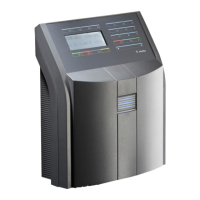I/O controller boards of the slave terminals. The characters - + mean:
▪ - + = 1st First I/O controller board for door control is ready for operation.
▪ + - = 2nd Second I/O controller board (I/O extension board) is ready for operation.
▪ + + = 1st First I/O controller board and 2nd I/O controller board ready for operation
▪ - - = Slave terminal is operated without I/O controller board
6.3 How to apply the configuration
Restart the device in order to activate the configured data.
Changes to the password or the network parameters do not require a restart.
Restart without deleting data (warm start)
Select this variant – particularly during operation – in order to maintain the stored data.
Syntax: oc -s
Function: This function causes a system reset that corresponds to a warm start via a button or a voltage
breakdown. The system restarts, no data is deleted.
Restart with deletion of data (cold start)
You can use this command during startup of the device.
Syntax: oc -c
Function: Deletes the entire memory (including credentials with booking permission, data for offline
operation) except the system log book and reboots. The network parameters and the password are
retained unchanged.
6.4 Preparing to update software
You require the PuTTY program package for execution. This is a free, open-source SSH, and Rlogin
client that facilitates remote operation of Unix systems by Windows computers.
Install the PuTTY program package (entire package, version >= 0.62).
Updates or upgrades are performed using batch files, in which C:\Programs\PuTTY is specified as
default installation path for PuTTY.
The path for the programs pscp.exe and plink.exe (part of PuTTY) is defined in the batch file
setpathvars.bat. The system password can also be found here.
Open setpathvars.bat in an editor and enter the system password.
Adjust the paths for the programs pscp.exe and plink.exe if required, for example if you have
saved PuTTY on a USB stick.

